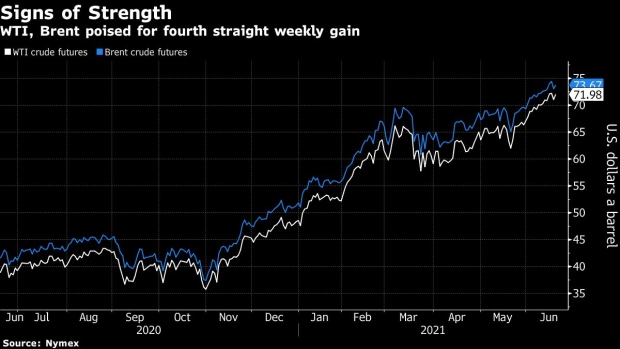Jun 18, 2021
Oil rises for fourth week with strong global demand ahead
, Bloomberg News

Oil posted a fourth straight weekly gain as signs of a global demand recovery and supply discipline among producers encouraged investors.
Futures in New York rose 1 per cent this week. Strong U.S. demand growth is being passed on to Europe and emerging markets, where India is also starting to show improvements, according to Goldman Sachs Group Inc. In a Bloomberg Television interview on Friday, Energy Aspects Ltd.’s Amrita Sen said the oil market could see an “incredibly” tight summer, and earlier this week, Morgan Stanley boosted its crude price forecasts. Prices are continuing to be supported by OPEC+ producers’ discipline in returning supply to the market.
“We continue to expect a demand rebound in the second half of the year,” said Bart Melek, head of commodity strategy at TD Securities. “We’re seeing vaccine programs being rolled out in earnest around the world, and much of America is already opening up as the driving season is starting.”

Oil has rallied nearly 50 per cent this year with widespread vaccinations boosting demand, while the Organization of Petroleum Exporting Countries and its allies have been cautious about returning shuttered supply to the market. Shale producers in the oil-rich Permian Basin have been largely holding back, too. The U.S. is pumping about 1.9 million fewer barrels a day since COVID-19 caused prices to tumble last year, a reduction that’s bigger than Nigeria and Venezuela’s production combined.
“The proof is in the pudding,” said John Kilduff, a partner at Again Capital LLC. “We haven’t seen a real strong rebound in Permian activity, and we’re continuing to watch pipelines out of that area be underutilized.”
Global oil demand has likely hit 97 million barrels a day recently, up from 95 million a few weeks ago, according to Goldman Sachs. Consumption before the pandemic stood at around 100 million barrels a day. The bank said oil is its “highest conviction” bullish call in commodities.
Earlier in the session, West Texas Intermediate crude’s discount to the global benchmark narrowed to less than US$2 a barrel for the first time since November. The spread has shrunk significantly in recent weeks on signs of higher U.S. refining throughput and continued supply discipline by American producers.
Prices:
- West Texas Intermediate for July delivery rose 60 cents to settle at US$71.64 a barrel in New York.
- Brent for August settlement climbed 43 cents to end the session at US$73.51 a barrel.
The Federal Reserve’s announcement this week of two prospective interest rate hikes by 2023 contributed to a stronger dollar, making commodities priced in the currency more costly. That triggered a commodity selloff earlier in the week.
“The prospect of earlier interest-rate rises propelled the dollar higher and provided traders with an excuse to take profit,” said Stephen Brennock, an analyst at brokerage PVM Oil Associates.
Investors are also tracking the situation in Iran. Talks between Tehran and world powers to revive a nuclear accord and potentially allow a resumption of official crude flows have yet to bridge remaining differences. Iranians are voting Friday in a presidential election to pick a replacement for Hassan Rouhani, a moderate who helped shepherd the original 2015 deal.
Related news:
- China has stepped up an investigation into private refiners, including in the little known hub of Panjin.
- The U.S. oil market is reaching a crunch point: while demand is surging, wildcatters aren’t firing up rigs like they used to.



